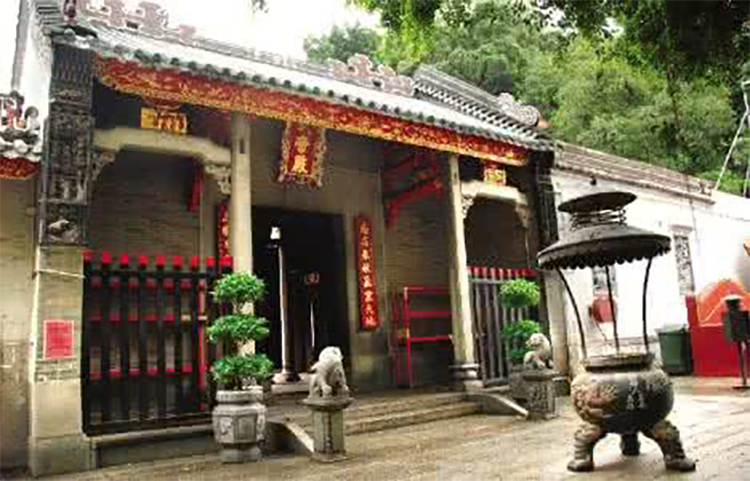Puji Zen Temple: Lingnan Architecture at Macau’s 400-Year Guanyin Sanctuary
Puji Zen Temple: Macau’s 400-Year Guanyin Sanctuary
Lingnan Temple’s Soul Portrait
As you pass through the bustle of Avenida do Almirante Lacerda, a cluster of grey-tiled, blue-brick buildings appears suddenly—this is Puji Zen Temple, affectionately known by locals as the “Guanyin Hall.” As the oldest of Macau’s three historic Buddhist temples, founded in 1627, Puji stands like a patient elder witnessing centuries of change. It condenses Lingnan architectural elegance, the compassionate spirit of Guanyin worship, and echoes of modern Chinese history into a hillside ensemble. Stroll beneath the animated ceramic roof figures that seem to whisper, rest in the shade of a centuries-old bodhi tree, and meet the solemn Thousand-Armed Guanyin whose many eyes gaze upon every pilgrim.
1. Historical Landmark Across the Ages
1.1 From Ming-Era Devotion to a Modern Historical Stage
Puji Zen Temple was established in the seventh year of the Tianqi reign (1627), during Macau’s heyday as a hub of East–West exchange. For four centuries it has been a spiritual home for Buddhist devotees and, notably, the rear garden’s stone table and benches witnessed the signing of the 1844 Treaty of Wanghia between China and the United States. This dual identity—sacred site and historical venue—gives Puji a unique place in Macau’s cultural heritage.
1.2 Guanyin Practice and Faith Transmission
As a major Guanyin worship center in the Lingnan region, the temple belongs to the Chan (Zen) tradition yet blends orthodox Buddhist ritual with popular folk practices. The main hall houses a magnificent Thousand-Armed, Thousand-Eyed Guanyin statue: each of the forty visible arms holds ritual implements (each hand and eye symbolizing different methods of saving beings), together evoking the idea of a thousand compassionate ways. Devotees come to pray for safety, health, and wisdom. On Guanyin’s birthdays (lunar Feb 19, Jun 19, Sep 19), elaborate blessing ceremonies fill the air with chanting.
2. An Immersive Exploration of Architectural Art
2.1 The Spatial Poetics of a Lingnan Temple
The temple follows the traditional seven-hall Buddhist layout along a central axis: mountain gate, Hall of Heavenly Kings, Mahavira Hall, and Guanyin Hall, arranged up the slope to create a sense of ascending pilgrimage. Highlights of Cantonese (Guangfu) craftsmanship include:
– Roof artistry: glazed tiles and molded ridge sculptures form a dazzling skyline; the “Two Dragons Playing Pearl” ceramic sculpture has retained vivid color despite three centuries of weathering.
– Wood-carved codes: openwork panels on the doors depict Buddhist birth tales and hide auspicious motifs—swastika patterns, floral treasures, and other symbols.
– Light and shadow play: afternoon light streams through latticed windows, casting shifting patterns on blue-brick flooring.
2.2 Must-See Artifacts
Behind the Guanyin Hall, the sutra repository preserves a Qing-dynasty silk scroll painting of the Five Hundred Arhats—figures in flowing robes with varied expressions that showcase the peak of Lingnan gongbi color-and-line painting. Flanking the Mahavira Hall are eighteen Arhat sculptures, each about 1.5 meters tall, made with lacquered cloth molding (qi bu tuo tai) with robes carved to flow like clouds—arguably the most intact group of Qing-era Buddhist sculptures remaining in Macau.

3. Visitor Experience Guide for Contemporary Travelers
3.1 Best Times to Visit
– Dawn (6:30–8:00): Observe the monks’ morning liturgy and listen to bell and chant harmonies.
– Afternoon calm (14:00–16:00): Sip tea beneath a centennial banyan and watch sunlight dance across carved doors.
– Recommended special event: Sunday morning scripture talks (Cantonese / Mandarin) are open to non-believers and offer accessible Buddhist insights.
3.2 Deeper Cultural Experiences
1. Symbol hunt: look for hidden Buddhist motifs—lotus, vase, Dharma wheel—woven into decorative details.
2. Tree dialogue: touch the camphor tree said to be 300 years old and trace typhoon scars on its trunk.
3. Historical immersion: stand by the Treaty of Wanghia site in the rear garden and compare the scene with archival photos to imagine 1844.
4. Practical Visiting Notes
4.1 Basic Information
– Address: Avenida do Almirante Lacerda (near Fort Hill), Macau Peninsula
– Opening hours: 08:00–17:30 daily
– Admission: Free (donations welcome)
4.2 Getting There
– Bus: Routes 7, 7A, 8 to “Guanyin Hall” stop, 2-minute walk
– Walk: About 20 minutes north from the Ruins of St. Paul’s along Estrada de S. Tiago da Barra
– Tip: The road in front of the temple is one-way; use the “Macau Taxi” app for reliable rides.
4.3 Etiquette
– Dress: Shoulders and knees covered recommended (free shawls available at the entrance).
– Photography: No flash inside; please avoid photographing the Guanyin statue directly.
– Offering incense: Free eco-friendly incense is available at the gate—follow the traditional left-hand incense offering.

5. Nearby Cultural Connections
Combine Puji Zen Temple with nearby sites for a full Macau cultural day:
1. Morning: Puji Temple (1.5 hours) → Macau Tea Culture House (8-minute walk)
2. Lunch: Temple vegetarian fare or nearby longtime eatery “Wing Kee Tofu & Noodles”
3. Afternoon: Wangxia Hill mural walk → Tap Seac Arts and Cultural Center
4. Evening: Walk to Guia Lighthouse for sunset viewing
In Macau—a city of intense East–West cultural encounters—Puji Zen Temple stands as a quiet witness. Touch the soot-darkened beams, rest by the old garden well, and you’ll sense a calm beyond religion: the spiritual home that generations of Macanese have found for 400 years. Plan at least two hours to let this living architectural museum unfold its stories of faith, art, and history.


